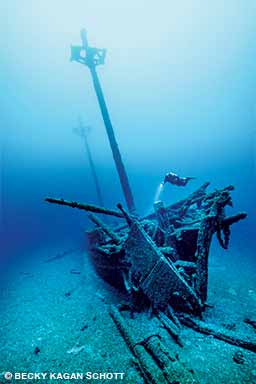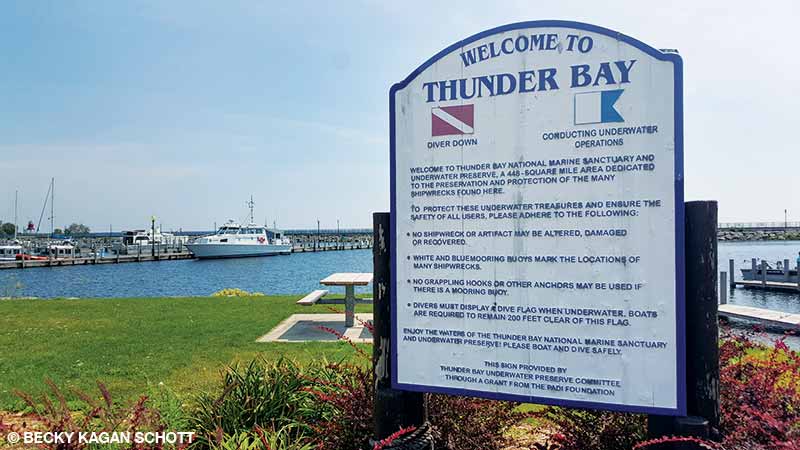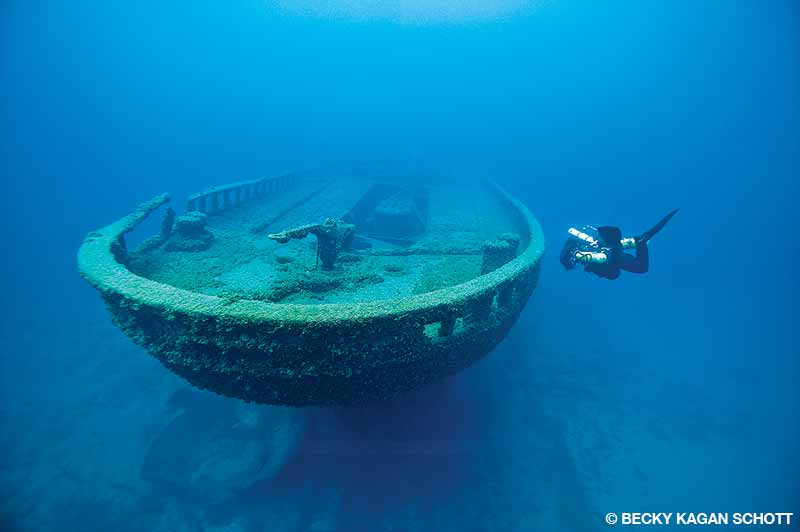Thunder Bay National Marine Sanctuary is America’s treasure.
The Florida Keys, Flower Garden Banks off the Texas coast, California’s Channel Islands and North Carolina’s USS Monitor shipwreck are among the more well-known of the 14 national marine sanctuaries the National Oceanic and Atmospheric Administration (NOAA) manages. They are all incredible, but every summer one of my must-visit shipwreck destinations is the Thunder Bay National Marine Sanctuary in Lake Huron off the northeastern coast of Michigan.

Thunder Bay has nearly 100 known shipwrecks, and others are still being discovered. The oldest shipwreck there sank in 1849, but many wrecks are from the mid- and late 1800s to the early 1900s. The location, history and variety of ships — from wooden schooners to freighters — make Thunder Bay special. The wrecks are at various depths, ranging from the snorkel zone to recreational and technical diving levels.
Known as Shipwreck Alley, this area has unpredictable weather, strong winds, dense fog and rocky shoals that have sent many ships to the lake bottom. Collisions, fires and ice have also contributed to the collection of wrecks throughout the Great Lakes. History is preserved below the surface here, with vessels ranging from modern steel freighters to a pre-Civil War sidewheel steamer. The national significance of this history led to the sanctuary’s creation in 2000 and expansion in 2014 from 448 to 4,300 square miles. Future NOAA expeditions will further explore Thunder Bay, which may hold up to 200 wrecks.
In 2011 I worked with NOAA and Sony on the Project Shiphunt documentary. We spent a few weeks in Alpena, Michigan, searching for unexplored wrecks and found the schooner M.F. Merrick and the inverted freighter Etruria in more than 300 feet of water. We were the first people to lay eyes on them in more than a century. I left Michigan with a new obsession: diving the Great Lakes.
During my time there, I met passionate archaeologists from the sanctuary and spent a lot of time at the beautiful museum in Alpena. Their enthusiasm for protecting the resources and educating the public was infectious. After I left, I couldn’t get the wrecks out of my mind; later that year, when the water warmed to at least 38°F, I revisited the sanctuary. The perfectly preserved wooden wrecks and schooners were irresistible draws. Sitting on the bottom with their masts standing straight, they look as if they are still sailing. In my mind this was how shipwrecks should always look.
Few charters visit the wrecks, even though many sites have buoys. Most of the charters are for six passengers and run for only a few months during the summer. When you first pull out of the marina, the Caribbean-blue water is visually impressive, but it’s not Caribbean warm. Temperatures can range from 37°F to 40°F on the bottom and are usually in the 60°F range in late summer from 30 feet to the surface. Many recreational divers wear thick wetsuits, but I highly recommend a drysuit.

The best months to dive are June through September, when air temperatures are pleasant and conditions vary from dense fog to full sun. Most areas usually have little to no current, and most of the sites have a mooring buoy for ascents and descents and to protect the wrecks from anchor or grapple damage. Invasive quagga mussels have cleaned the water over the past two decades, leaving stellar visibility that typically ranges from 50 to more than 100 feet.
These are natural shipwrecks, many of them wooden, and the cold, fresh water has preserved them. They would not be intact or possibly even exist if they were in salt water. Diving here is like being inside a time capsule. The wrecks are irreplaceable, so it’s important not to damage them, and it’s illegal to remove any artifacts from the sites. As a photographer I enjoy descending to a shipwreck and seeing the wooden wheel in place, a bell, a galley full of teacups and plates, and personal belongings such as binoculars and clothing still there. Each wreck has an extraordinary story and history to tell through its remaining artifacts.
Thunder Bay is my favorite place to wreck dive because everything is well preserved, and the stories of mystery, tragedy and survival are captivating.
Recreational Sites
El Grecian was a 296-foot steel bulk freighter that first sank in 1906 after hitting a submerged rock in the St. Mary’s River. The ship was refloated, but it suddenly sank again while being towed to Detroit for repairs. The entire crew survived, but the vessel met its final resting place in 100 feet of water. The bow and stern are upright and intact, but the midsection has collapsed. At this popular site, divers can see the propeller, engine, boiler and deck equipment. The bow still has the windlass and sits with a slight starboard list. The Grecian. sister ship, the Norman, rests 30 miles north in 200 feet of water.

El Monohansett at just 20 feet deep is excellent for snorkeling or diving. Built in 1872, this wooden steam barge was 160 feet long and carried loads of coal. The ship caught fire in November 1907 and burned to the waterline near Thunder Bay Island. The crew suffered minor burns and lost their belongings, but all survived thanks to the life-saving station on the island. Diving the Monohansett is a great experience. It sits in three sections, but the water is generally so clear you can see most of the wreck from the surface. Divers can swim along the hull, which looks like ribs, and see the propeller and shaft. The large boiler sits nearby at this photogenic site.

El W.P. Thew was a 132-foot steam barge launched in 1884 and designed to carry logs, lumber, railroad ties and shingles, one of many 19th-century steamers intended for this purpose. After 25 years in service, the W.P. Thew sank in 1909 when it collided with a freighter in heavy fog. The damage sent it to its final resting place in 84 feet of water. Machinery, deck equipment, boilers and other artifacts are splayed out on the bottom. You can make out the fantail, and the prop and shaft are visible. Many eel-like burbot fish are typically at this site, so watch for the rounded tail fin.
El E.B. Allen is another popular recreational site, especially for divers wanting to see a wooden schooner. This 134-foot-long, two-masted schooner sank in November 1871 while carrying a cargo of grain to Buffalo, New York; a heavy fog developed, and the schooner Newsboytore a large hole in the portside hull. The crew made it aboard the Newsboy before watching the E.B. Allen disappear below the waves into 100 feet of water. Today the wreck sits upright with its masts fallen. When you first descend and the ship comes into view, the schooner’s windlass and anchor chains are visible on the bow. When swimming along the deck, you’ll see other machinery, and the rudder is still at the stern but mostly buried in the lake bottom.

El Joseph S. Fay is one of my favorite sites. Visitors can access the site from shore near 40 Mile Point Lighthouse by snorkeling, diving, paddleboarding or boating. It is a bit of a swim, but the shore slopes gradually to where the wreck sits in 18 feet of water. A buoy marks the site. The 216-foot bulk freighter Joseph S. Fay was built in 1871 and carried iron ore. In October 1905 it encountered a fierce gale in northern Lake Huron and hit submerged rocks at 40 Mile Point. The ship, which was fully loaded and towing the ore-carrying barge D.P. Rhodes, quickly broke apart, and its stern split open. The hull and iron ore cargo still sit on the bottom along with the rudder, shaft and some artifacts. A large portion of the freighter’s starboard side is on the beach to the north of the lighthouse. Depending on conditions, it can sometimes be visible or otherwise covered in sand. The underwater visibility is generally excellent, and the water here is much warmer than on deeper sites.

Technical Diving Sites
El Typo was a three-masted wooden schooner that sank after a collision on Oct. 14, 1899. It sits upright with the bowsprit intact and all its rigging in place. As you descend toward the wreck, a mast protrudes from the dark depths at around 100 feet. Upon reaching the wreck at 170 to 195 feet, you’ll see the windlass and two wooden stock anchors stowed on the bow railings before encountering the ship’s bell. Not many bells remain on shipwrecks, so it’s exciting to see one. The bowsprit is stunning, and if you descend into the sand to look up at it, it almost looks like something from a movie set. Fallen masts, deadeyes, pulleys and other rigging are on the deck. The Typo was carrying coal when it was struck, and it went down hard and fast. The stern bears the impact damage, and coal litters the lake bottom. Many artifacts are in the coal piles, including the remains of the four crew members who went down with the ship. Divers are respectful and do not disturb them.

El Cornelia B. Windiate disappeared during a fierce storm in November 1875. It was presumed to have sunk in Lake Michigan, but it was discovered in Lake Huron more than a century later. No one knows what happened to the crew of nine. Next to the wreck sits the yawl boat, which is a haunting reminder that all hands were lost. This 138-foot three-masted schooner was in perfect condition when discovered in 1986. All three masts are standing, the wheel is intact, a spiral wooden staircase leads into the preserved cabin, and the rudder is turned hard. The bow has wooden stock anchors and a windlass, but the bowsprit is broken. If you look closely on the portside stern, you can still read the name Cornelia B. Windiate etched into the wood. Plenty of artifacts remain on the deck to see, but the real gem is simply letting yourself be taken back in time.
El Newell A. Eddy was a 242-foot three-masted schooner barge that carried wheat. While under tow in April 1893, the Newell A. Eddy broke free from its consort, the Charles A. Eddy, during a strong gale. The storm took the ship and its entire crew. A research vessel discovered the wreck in 1992 with all three masts standing and in pristine condition in 168 feet of water near Cheboygan, Michigan. This impressive ship sits on the boundary of the sanctuary. There is typically no mooring, but captains will put out a jug to mark the downline, which does not go to the wreck but rather to an anchor chain sprawled out across the lake bottom. When you get to 120 feet on the line, you can start looking for the wreck or continue on the line to the bottom and follow the anchor chain. The visibility is usually just enough to see the tip of the big bowsprit. I typically put a strobe on the downline as a visual. This enormous wreck has an intact deck at about 135 to 140 feet, and dropping inside the cargo holds takes you to 165 feet. The impressive bowsprit and standing masts are incredible. There is still rigging, and most of the Newell A. Eddy is very well preserved, although parts of the stern have broken away. Visibility can vary from 40 to 70 feet, and this area tends to have a lot of particulates in the water.

El S.S. Floridawas a 270-foot wooden steamer built in 1889 in Buffalo, New York, that carried a mix of package freight. On a foggy day in May 1897, the steamer George W. Roby struck the Florida, almost cutting it in half. The Florida sank in 12 minutes to 206 feet, where it sits mostly intact. The distinct V shape from the collision on its starboard side is impressive and a great opening for entering the wreck and seeing its freight of flour, merchandise and lard barrels. Some barrels float against the ship’s ceiling, and others have broken open, leaving bright white mounds on the floor. A portion of the galley reveals a teapot and other dishes. On the bow the anchors sit tight, and the capstan reads S.S. Florida 1889. The stern has collapsed, exposing the engine with its gauges visible. An iron bell sits nearby, off the port side near the break on the stern.
The Thunder Bay National Marine Sanctuary protects and manages these exceptional and historical shipwrecks. The wrecks highlighted here are only a fraction of what you can find in this area of the Great Lakes. NOAA and other shipwreck hunters discover new wrecks every few years using the latest sidescan technology and advances in dive technology. Diving these wrecks makes me realize there is still so much more to discover. Visiting a shipwreck that not many people have seen for more than 140 years is beyond unique, and there are few places in the world where you can dive and feel like you’ve gone back in time.
To learn more, visit thunderbay.noaa.gov/welcome. View Schott’s photogrammetry on the Joseph S. Fay en https://skfb.ly/6U7Ys.
Explore más
See more of Thunder Bay National Marine Sanctuary in a galería de fotos complementaria and these videos.
© Alert Diver - Q2 2021